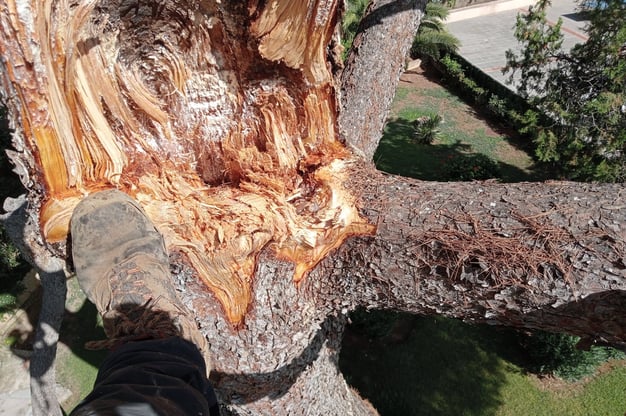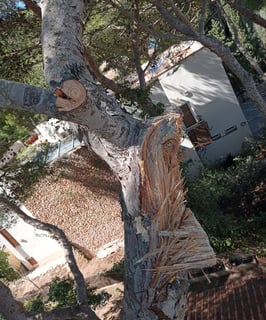Mechanical or Structural Breaks in Trees: Causes and Prevention


Trees are an essential element of the landscape, but they can also face issues that compromise their health and safety. One of the most common problems is the breaking of branches, which can pose a risk to people, property, and the tree itself. In this post, we will explore the main causes of these breaks and how to prevent them.
Main Causes of Branch Breaks
Strong winds and storms: Intense wind episodes or storms are one of the most common causes of branch breaks. Trees with weak or poorly balanced structures are more prone to damage.
Excess weight from snow or ice: In cold areas, the accumulated weight of snow or ice can cause branches to break, especially those already weakened.
Improper pruning: Incorrect pruning can leave poorly healed wounds or poorly distributed branches, weakening the overall structure of the tree.
Diseases and pests: Fungal infections, bacterial diseases, or insect attacks can weaken branches, making them more susceptible to breaking.
Defective or rotten wood: The presence of rotten wood or internal cavities can reduce the mechanical strength of the tree.
Unbalanced growth: Branches that grow at sharp angles or compete for space can create internal tensions that increase the risk of breakage.
How to Prevent Branch Breaks
Regular inspections: Regularly checking the tree’s condition helps detect signs of weakening, such as cracks, rotten wood, or pest infestations.
Proper pruning: Perform regular, professional pruning to remove dead, diseased, or misoriented branches. Pruning also helps distribute weight evenly.
Choosing suitable species: When planting trees, choose species that are adapted to the local climate and soil. This will reduce tree stress and improve resilience.
Preventive treatments: Apply phytosanitary treatments to combat pests and diseases that could weaken the branches.
Support systems: For large trees or trees with critical branches, cables or supports can be installed to reinforce the structure.
Avoid drastic cuts: Severe pruning can lead to weak growth that is more prone to breaking.
What to Do in Case of Breakage
If a branch breaks, it is important to act quickly to minimize the damage:
Safely remove the broken branch: If accessible and safe to handle, remove the broken branch to prevent it from falling accidentally.
Clean the wound: Use clean tools to cut the affected area, ensuring a smooth surface to facilitate healing.
Consult a professional: For large trees or complex situations, contact an arborist for proper intervention.
Branch breaks are common problems, but with good prevention and maintenance, risks can be minimized, ensuring the health and safety of trees over time. If you have any doubts or need assistance with tree care, don’t hesitate to reach out to us!




